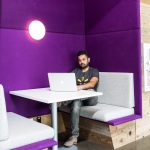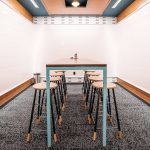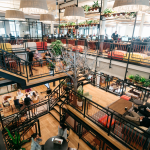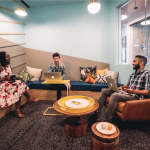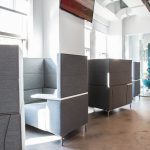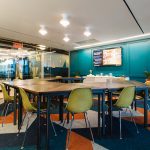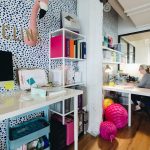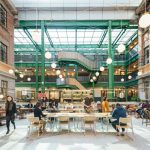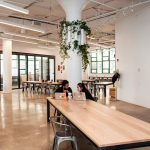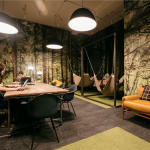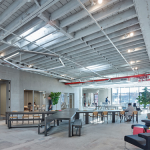Awesome offices
 12 awesome offices reveal what work will look like in the future
12 awesome offices reveal what work will look like in the future
By Rachel Gillett From Business Insider
The workplaces of the future will be geared towards elevating worker performance in some unexpected ways.By WXY architecture + urban design, courtesy of Kearny Point
If your vision for the future workplace is a drab, cold warehouse sparsely dotted with drone employees, think again.
Over the next decade and beyond, workplaces will be geared more towards the needs of its employees, which will mean a diverse mix of spaces, furniture, and amenities, experts say.
“My view is that we’re going to see more and more flexibility in workplace design,” social psychologist and “The Best Place To Work” author Ron Friedman told Business Insider.
In researching his book, Friedman analyzed thousands of academic studies in behavioral science to better understand the conditions that help us work more effectively. In the past, he said the focus of workplace design has been on saving space, primarily for financial reasons.
“That’s changing as the knowledge economy grows, and there’s a greater appreciation for the extent to which the brain is influenced by its surroundings,” he said. “Offering a selection of spaces for workers to choose from is going to become essential for business success.”
To determine what this trend of designing workspaces around elevating worker performance might look like in the future, Business Insider also conferred with experts from office space rental company WeWork, research and advisory firm CEB (now part of Gartner), and architecture firms WXY architecture + urban design, nARCHITECTS, and ESI Design.
In designing workspaces that will serve the future workforce, Mimi Hoang, a principal at nARCHITECTS, told Business Insider, “the aim is to create synergies and spontaneous opportunities for collaboration through the diverse mix of work-related functions.” Workspaces of the future will essentially function as “an expanded ecosystem.”
“The day of everyone sitting by themselves at their own desk is coming to a close,” Michael Schneider, a senior designer and A/V technologist at ESI Design told Business Insider. “With interpersonal, creative work proving more resilient to automation than many of the rote jobs conducted at individual work stations, expect the office of the future to be centered around collective spaces.”
Emily Webster, a senior designer and A/V technologist at ESI Design, also told Business Insider that, as more and more jobs are handled by freelancers or gig workers passing through temporary spaces, offices will “need to prevent employees from feeling like strangers waiting at a bus station.”
Based on these conversations, we’ve compiled a number of workspace design elements we may see over the next ten years and beyond.
Join us on a tour of the workplace of the future:
Mixed workspaces that workers share will allow employees to move around based on their mood or the type of work they need to do.
WeWork Weihai Lu office in Shanghai.Courtesy of WeWork
Meanwhile, private offices will still offer teams that require closed collaboration a space to work.
WeWork Dumbo Heights office in Brooklyn, NY.Courtesy of WeWork
Source: HBR
Open collaboration spaces will feature various seating options like long, communal tables …
Etsy Headquarters in Brooklyn, NY.Sarah Jacobs
… cubbies …
… cubbies …
Jet Headquarters in Hoboken, NJ.Sarah Jacobs/Business Insider
… and soft lounge seating.
Etsy Headquarters in Brooklyn, NY.Sarah Jacobs
Hideaway nooks in particular can help lower anxiety levels for some workers.
Hideaway nooks in particular can help lower anxiety levels for some workers.
TED Conferences headquarters in New York.Sarah Jacobs/Business Insider
Source: 99u/Ron Friedman
Some communal space furniture design like sawtooth counter-spaces and X-shaped “crosstalk” tables will help facilitate conversation and information sharing.
nARCHITECTS’s ADO creative space in Brooklyn, NY.Courtesy ADO + nARCHITECTS, by Matthew Carbone
While private phone booths with a small work surface and seating will allow for the privacy not afforded by open-plan workspaces.
Business Insider’s WeWork office in San Francisco.Melia Robinson/Business Insider
Quiet rooms will also allow employees get away from the noise and distractions of an open workspace, recharge, and do more focused work.
WeWork Chelsea headquarters in New York.Courtesy of WeWork
Large conference rooms will still allow large groups of people to meet at a time. Technology will allow people to book conference rooms in any city or area.
WeWork Crystal City office in Arlington, Virginia.Courtesy of WeWork
Smaller conference rooms will cater to the nature of the meeting.
WeWork Soho Sheraton House office in London.Courtesy of WeWork
Conversation conference rooms, for example, will be more intimate and designed with acoustics in mind. Low tables, comfortable seating, table and floor lamps along with layered materials and textures provide an escape from the formality of a standard conference room at WeWork.
WeWork University Park office in Austin.WeWork
Brainstorm rooms, on the other hand, would be covered in whiteboards or other surfaces that lend themselves to problem-solving on the fly.
WeWork University Park office in Austin.Courtesy of WeWork
.
Centrally-located staircases may be used as a way to not only physically connect people on different floors, but also as a communal space that drives collaboration.
WeWork Chelsea headquarters in New York.Courtesy of WeWork
For more on this story go to: http://www.businessinsider.com/photos-an-inside-look-at-the-coolest-workplaces-of-the-future-2017-10/#mixed-workspaces-that-workers-share-will-allow-employees-to-move-around-based-on-their-mood-or-the-type-of-work-they-need-to-do-1

